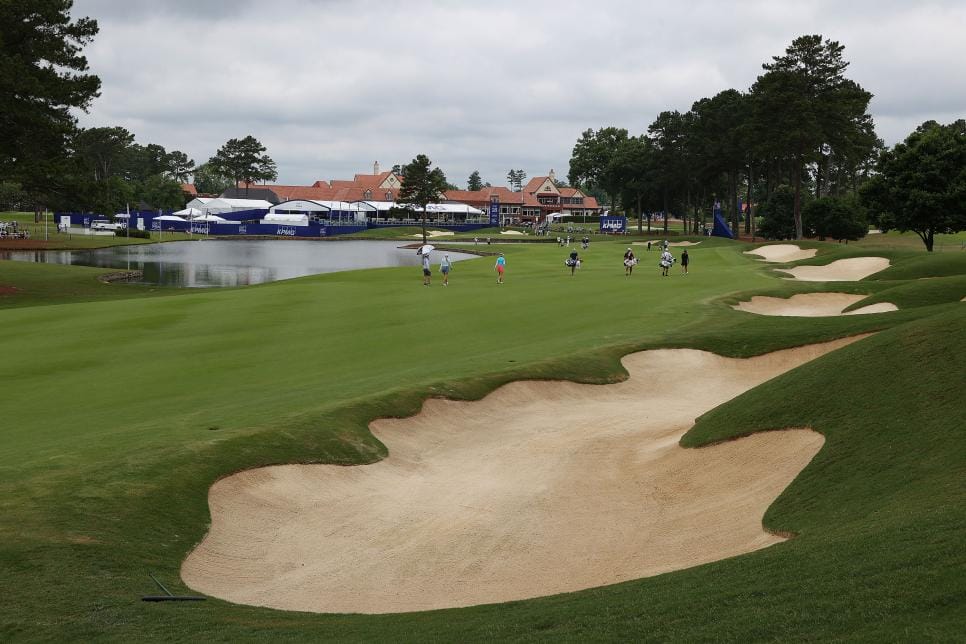What To Expect — Familiar And New — From Atlanta Athletic Club At This Week’s KPMG Women’s PGA
Shane Ryan
Golf Digest

JOHNS CREEK, Ga. — Depending on the strength of your memory, you might recall seeing the Highlands Course at the Atlanta Athletic Club during the 2011 PGA Championship (winner: Keegan Bradley), the 2001 PGA (David Toms) or even, going way back, the 1976 U.S. Open (Jerry Pate). The course plays host to the KPMG Women’s PGA Championship this week, part of a broader movement to bring the women’s game to traditional championship courses, and while some of the elements remain the same from previous men’s majors, a 2016 redesign by Rees Jones and a few alterations since mean it won’t be quite the track you remember.
Kerry Haigh, the Chief Championship Officer at the PGA of America, had a huge hand in preparing the course, and spoke on Wednesday about what might be the biggest change, which is a new tee on the par-4 sixth hole that shortens the hole to around 240 yards and makes it—at least theoretically—drivable.
“There was a tee for the men’s PGA Championship, but I felt it was important that we had one for the Women’s PGA, the KPMG,” he said. “It makes you think. Do you lay up short of the lake, which is really not much club at all? Or do you go for it? There’s plenty of room to the right to bail out, but then it’s a really tough chip if you do miss it right. But obviously you’re rewarded with a birdie or eagle if you’re straight. It should be fun to watch.”
Haigh also spoke of the general difficulty of the course, particularly on the back nine when water comes into play. From the approach on 11 to the par-4 12th (which also seems like it will be reachable for at least one day of the championship) to the 200-yard downhill par-3 15th, the water is constantly looming.
Lukus Harvey is the Director of Agronomy at AAC, coming over from a similar position at PGA National in 2015. The Rees Jones renovation came a year into his tenure, and along with re-grassing the fairways (zoysia) and greens (bermuda), they took out more than an acre of bunkers. Many of those would only have affected member golfers—Harvey said that bunkers impacting championship play are mostly intact—but it’s a major cosmetic difference anyway, with a series of trees, from black maples to loblolly pines to white oaks, planted to serve as visual framing anchors in areas where tree cover around the fairways had grown sparse.
Perhaps the change that will affect play the most, though, came around the putting areas.
“One of the big focuses was the green surrounds,” Harvey said. “We took out some bunkers, but it was more about strategy, to add a more challenging element for players. A lot of these roll-off, tightly mowed chipping areas we grassed with tifgrand, which is a dwarf Bermuda grass. And we maintain them at a quarter inch, so they’re really, really tight. And what it does is force the player to make a choice. Can you really get down and nip it with the wedge? There’s no cushion underneath it. Or are you going to putt it, or are you going to do a Texas wedge type thing or a rescue?”
There was nothing like that at AAC in the past, including for the 2011 PGA. The 14th green was also completely re-tiered, allowing for a tough back-left pin position, and in general the short game should play tougher than we’ve seen in the past, putting a premium on accuracy into the green and finesse when those approach shots that miss the putting surface. Heavy rain earlier in the week raised the possibility that nature would dull the sharp edges in this regard, but recent weather has dried things out, and Harvey—whose team numbers in the 80s for this week, up from 65 normally—mowed the greens and surrounding areas Wednesday night to ensure the course would show its teeth on Thursday. (Anecdotally, from watching practice rounds Wednesday, the greens themselves look very, very fast, though Harvey wouldn’t reveal the speed he and his crew were targeting.)
Harvey and his team have been preparing for this tournament for months, and one of the unique challenges is that the growing season for their turf hits its stride in mid-to-late summer, which is fine for PGA Championships in August, but more challenging for a June event. While waiting for the bermuda and zoysia to come out of dormancy, club members made the sacrifice by hitting off mats in the fairways to ensure that they wouldn’t take divots, since those divots might not grow back quickly enough for this week’s major.
“The members are so fantastic,” Harvey said. “I mean, they love it. They’re excited to have the course on a global stage, so they were very supportive of doing that work.”
All of Harvey’s work, from fertilizer to fungicide programs to verticutting and top-dressing the greens, was geared at making sure the timing would be perfect, and that he’d be at peak growth rate this week. The dry weather in June was exactly what he wanted, although the tropical storm that came through last week threw him a curveball, but with play beginning Thursday, he’s satisfied with how the course will play.
At this point, aside from mowing the fairways after Thursday’s round, the work is mostly done, and the players take center stage. That stage will be somewhat familiar to golf fans who remember AAC from majors past, but the subtle and not-so-subtle changes since 2016 mean that the actual tournament could look very, very different. Above all else, keep an eye on the wedges.